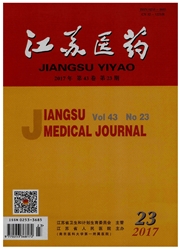

 中文摘要:
中文摘要:
目的探讨银杏内酯A在大鼠急性脊髓损伤后对神经纤维修复和运动功能恢复的作用。方法28只SD大鼠随机分为高剂量银杏内酯A组(A1组,6只)、中剂量银杏内酯A组(A2组,6只)、低剂量银杏内酯A组(A3组,6只)、损伤模型组(B组,5只)和假手术组(C组,5只)。损伤后不同时间段对大鼠进行BBB行为学评分,损伤后30d取脊髓损伤区域进行免疫荧光组织化学染色和电镜检测。结果A1、A2、A3组损伤后的BBB评分均高于B组(P〈0.05),A1、A2组BBB评分高于A3组(P〈0.05)。A1、A2、A3组均可见神经微丝蛋白免疫反应阳性的再生神经纤维,B组未见阳性神经纤维。电镜观察显示,A1、A2、A3组损伤区域内均可见神经纤维,且A1、A2组的有髓神经纤维数目多于A3组(P〈0.05)。结论银杏内酯A在大鼠急性脊髓损伤后能促进神经纤维的修复和运动功能的恢复,且高、中剂量银杏内酯A治疗效果优于低剂量银杏内酯A。
 英文摘要:
英文摘要:
Objective To investigate the effect of ginkgolide A(GA) on the repairing of nerve fibers and recovery of motor function after acute spinal cord injury(SCI) in rats. Methods A total of 28 SD rats was divided into five groups of A1 (injected with GA 30 mg· kg^-1 · d-1, 6 mice), A2 (injected with GA 20 mg· kg^-1 · d-11 ,6 mice) ,A3(injected with GA 10 mg· kg^-1 · d-1 ,6 mice) ,B(SCI model control,5 mice) and C(sham operated, 5 mice). BBB ethology score was recorded at different time periods after injury, and the injured region was observed by fluorescence immunohistochemistry staining and electron microscopy on the 30th day after injury. Results BBB scores in groups of A1, A2 and A3 were higher than those in group B(P〈0. 05) ,which in groups of A1 and A2 were higher than those in group A3 on the 10th , 15th , 20th 25^th and 30th day after iniury(P〈0. 05). The regenerated nerve fibers of immunoreactive positive neurofilament protein were observed in groups of A1, A2 and A3, but were not seen in group 13. Moreover, the nerve fibers in the injured region of groups of A1, A2 and A3 were observed under electron microscopy. Compared with group A3, the number of myelinated nerve fibers was significantly increased in groups of A1 and A2 (P〈0. 05). Conclusion GA can promote the repairing of nerve fibers and recovery of minor function after acute SCI in rats, and the therapeutic efficacy of GA with high and medium doses achieves a better result than that of low dose.
 同期刊论文项目
同期刊论文项目
 同项目期刊论文
同项目期刊论文
 期刊信息
期刊信息
